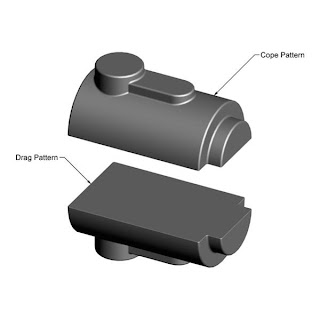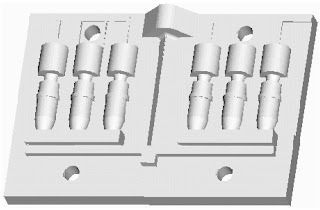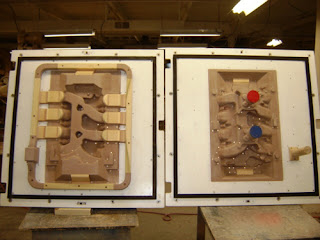Solid or single piece pattern:
A single piece pattern is the simplest of all the patterns, is made in one piece and carries no joint, partition or loose pieces. Depending upon the shape, it can be moulded in one or two boxes. The pattern is the cheapest but its use can be done to a limited extent of production only since its moulding involves a large number of manual operations like gate cutting, providing runners and risers.
Two piece or split pattern:
Many times the design of casting offers difficulty in mould making and withdrawal of pattern, if a solid pattern is used. For such castings, split or two piece pattern are employed. They are made in two parts which are joined at the parting line by means of dowels. While moulding one part of the pattern is contained by the drag and the other by the cope.
Multi-piece pattern:
Castings having a more complicated design than above require the pattern in more than two parts in order to facilitate an easy moulding and withdrawal of pattern. Their pattern may consist of 3, 4 or more numbers of parts, depending on their design.
Match plate pattern:
These patterns are used where rapid production of small and accurate castings is desired on a large scale. Their construction cost is quite high, but the same is easily compensated by a high rate production, greater dimensional accuracy and minimum requirement for matching in the casting, these patterns are made in two pieces, one piece is mounted on one side and the other on the other side of the plate called match plate. The plate may carry only one pattern, or a group of patterns mounted in the same way on its two sides. The plate may be of wood, steel, magnesium or aluminium. Gates and runners are also attached to the plate along with the pattern.
Gates patterns:
Skeleton patterns:
Sweep pattern:
Pattern with loose-pieces:
Some patterns usually single piece, are made to have loose pieces in order to enable their easy withdrawal from the mould. These pieces form an integral part of the pattern during moulding. After the mould it completes, the pattern is withdrawn leaving the pieces in the sand, which are later withdrawn separately through the cavity formed by the pattern.
Cope and drag pattern:
Follow board pattern:
Such single piece patterns which have an odd shape or very thin wall require a follow board. In the former case, the hollow board is provided with a cavity corresponding to the shape of the pattern in which the pattern is seated for moulding.
In the latter case, the follow- board carries a projection confirming to the inside shape of the thin walled pattern to support it during moulding. If such a support is not provided, the pattern may sag or get broken due to less wall thickness during ramming.
Segmental pattern:
These patterns are used for preparing moulds of circular castings, avoiding the use of solid pattern of exact size. If principle they work like a sweep, but the difference is that a sweep is given a continuous revolving motion to generate the desired shape, where as segmental pattern is a portion of the solid pattern itself and the mould is prepared in parts by it. It is mounted on a central pivot and after preparing the part mould in one position, the segment is moved to the next position. The operation is repeated till the complete mould is ready.
DESIGN CONSIDERATION IN PATTERNS
1. Proper allowance should be provided.2. The parting line should be carefully selected.
3. Proper material should always be selected.
4. The wall thickness and sections should kept as uniform as possible. Abrupt changes should invariably be avoided.
5. The use of offset pairing, instead of cores, should be encouraged to as great extent as it is possible. Abrupt changes should invariably be avoided.
6. For large scale production of small castings, the use of gated or match-plate pattern should be encouraged wherever the existing facilities permit.
7. All sharp corners and edges should be invariably provided with suitable fillets or otherwise rounded to enable an easy withdrawal of pattern, smooth flow of molten metal and ensure a sound casting.
8. All those surfaces of the castings which are specially required to be perfectly sound and clean should be so designed that they will be moulded in the drag.
9. The pattern should be given a high class surface finish as it directly effects the corresponding finish of the casting.
10. If gates, runners and risers are attached to the pattern, they should be properly located and their sudden contractions or enlargements should be avoided.
PATTERN LAYOUT
Pattern making consists of two different stages to prepare a layout and to shape the different parts. Layout consists of the following steps:a. Initially study the drawing pattern and select a wood that can suitably accommodate two views.
b. Take on surface of the wood as base and plane the adjacent surface.
c. Take a folding rule and measure the dimensions as per the drawing.
d. Prepare the layout by using various measuring and marking tools locating position of core prints and surface to be machined.
PATTERN CONSTRUCTION
a. As per the layout select locating of parting line.b. As per the shape of the pattern find out how many extra pieces to be made and how to construct them.
c. Select the wood and cut it so that direction of the grains lie along the length of pattern.
d. Provide sufficient draft allowance on the pattern.
e. Assemble all the separate pieces of the pattern by the help of dowels or glue and the check the parts completely by placing it over the layout.
f. Check the pattern as a whole for the specification.
g. Finish the rough surfaces and varnish it.
h. Fix the wax or leather wherever necessary then sand the complete surface and give final casting of shellac.
i. Different surfaces of pattern are colored by painting.
PATTERN COLORS
There is no universal method of coloring but following method is followed as a practice for coloring the patterns and core boxes.1. Red for machining surface
2. Black for un-machined surface
3. Yellow for core prints
4. Red strip on yellow base for seat for loose pieces
5. Without colour for parting surface
**Core prints: In a casting if we want to have a hole then this is done by core. This core is placed in the mould on the impressions made in the sand. These projections are core prints.














A good blog always comes-up with new and exciting information and while reading I have feel that this blog is really have all those quality that qualify a blog to be a one ADU Thousand Oaks
ReplyDeleteI have read your excellent post. This is a great job. I have enjoyed reading your post first time. I want to say thanks for this post. Thank you... ADU Los Angeles
ReplyDeleteThis is really a nice and informative, containing all information and also has a great impact on the new technology. Thanks for sharing it, drywall installation Ventura
ReplyDeleteWORK MY HELP FR DESING
ReplyDelete